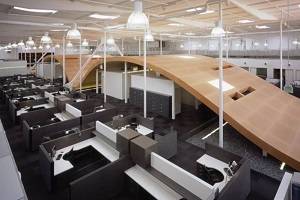April 4, 2013
Office design goes to the movies. Part 6 – Playtime
[embedplusvideo height=”192″ width=”220″ standard=”https://www.youtube.com/v/Qifl9saFtSw?fs=1″ vars=”ytid=Qifl9saFtSw&width=220&height=192&start=&stop=&rs=w&hd=0&autoplay=0&react=1&chapters=¬es=” id=”ep6472″ /]
One of the few films to address office design as something worth commenting on per se. A film in which M. Hulot stumbles around a modernist dream of Paris, all glass, steel and cold straight lines. People inhabit box like apartments and box like office cubicles which separate them from each other and, by implication, life. The film was produced in 1967, shortly before the cubicle was popularised in real offices. In the sequence in which M. Hulot visits an office building, he gets lost, gatecrashing meetings and ending up in a gadget trade show which is furnished in a virtually identical way to the office.





















April 5, 2013
What Tesco’s move into a Clerkenwell office tells us about how it sees itself
by Mark Eltringham • Comment, Property, Technology
(more…)